
Celebrate ten years of Urban Omnibus and support ten more years of fresh, independent perspectives on citymaking with a donation today!
Celebrate ten years of Urban Omnibus and support ten more years of fresh, independent perspectives on citymaking with a donation today!
Nestled deep in the heart of Staten Island, the New York City Farm Colony is a long-standing attraction to paintballers and urban explorers. The 45 acres, dotted with dormitories and facilities abandoned four decades ago after housing indigent New Yorkers working for their stay, has also proven beguiling to its landlord, the City of New York. How to redevelop this large plot of land, landmarked for its unique history and distinctive architecture in 1985? Many answers arose over the years — a housing development, a university campus — but each one fizzled, and with them chances at preserving progressively crumbling buildings on site.
So in 2013 when the City’s Economic Development Corporation chose a developer to bring the Farm Colony back to productive use with senior housing, it seemed to many a match made in heaven — not only for an uncanny commonality to the colony’s past in its catering to the old, but for the proposed project’s ability to foot the hefty preservation bill. To make that happen, the former poor farm is slated to welcome a much wealthier demographic than it once harbored and a housing model still new to the city: the luxury 55+ community. The planned Landmark Colony will be one of the city’s first “young-old” communities, a type proliferating nationwide and meant locally to meet the needs of a rapidly aging city. But the development’s relative isolation goes against much of the prevailing thinking around what models of housing best suit seniors. Here, Yael Friedman delves into the history of the Farm Colony, the plans underway to forge a new life for the site, and the questions each raise for how best to adapt our existing models of housing and care to an increasingly aged population. –J.T.
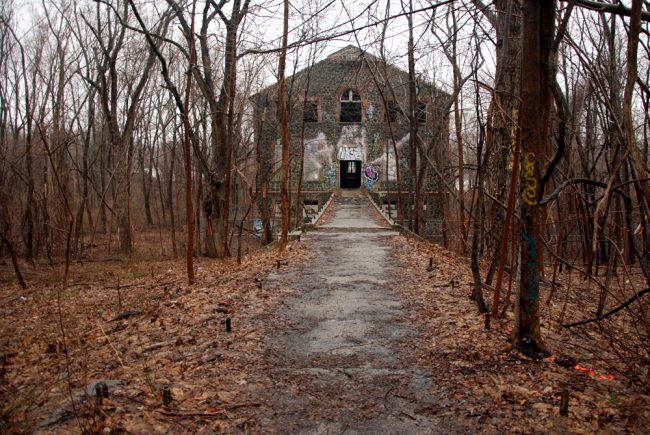
The Farm Colony Dining Hall, 2014 | Photo by Nathan Kensinger
In rural seventeenth century Staten Island, the “catastrophe to be dreaded was a childless old age.” With no younger generation to work the land and sustain a family, farmer Simion Corne went so far as to convey his house, land, and livestock to his neighbor in exchange for the care of Corne and his wife “… in sikness and in helth … during their lives.”[1]
Three hundred and fifty years on, Staten Island, projected to be New York’s oldest borough by 2030, stands at the precipice of a new demographic reality that challenges modern models of care and housing for seniors. The surge of aging baby boomers will soon combine with the twentieth century’s dramatic rise in life expectancy, leading to what has been called a “silver tsunami,” “demographic time bomb,” and other similar portents of calamity.[2]
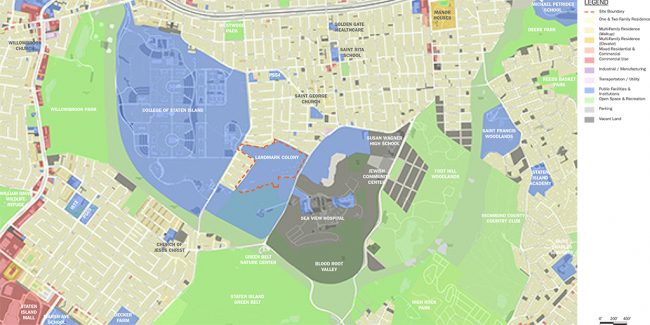
Zoning and land use map of Farm Colony area | Image courtesy of Nancy Owens Studio, map by NYC Planning
The development of a new retirement community in the Staten Island neighborhood of Willowbrook illustrates this seismic demographic shift. The developers of the Landmark Colony plan to raise a new complex from the ruins of the New York City Farm Colony, a poor farm founded in 1829 that itself provided for the old and infirm until its closure in 1975. After many years of attempts to rouse interest in the site’s development and multiple requests for expressions of interest, the City’s Economic Development Corporation finally found a match in Staten Island-based NFC Associates, to whom they conveyed the land for a nominal fee.[3] After approval by the Landmark Preservation Commission last November, the project, now under public review following certification by the NYC Department of City Planning, approaches actual construction.
Landmark’s 45-acre site lost its battle with a horde of invasive trees and vines long ago, its ruins all but disappearing within this eerie, overgrown ghost town in the heart of the borough. Over the next three years, NFC Associates and local firm Vengoechea + Boyland Architecture/Urban Planning plan to remake it into a type of senior community still new to New York: a luxury 344-unit residential development for the recently retired, age fifty-five and over. This development, a major project of historic preservation and reinvention, serves as a reminder of the need to radically reassess planning for a new era of aging in New York.
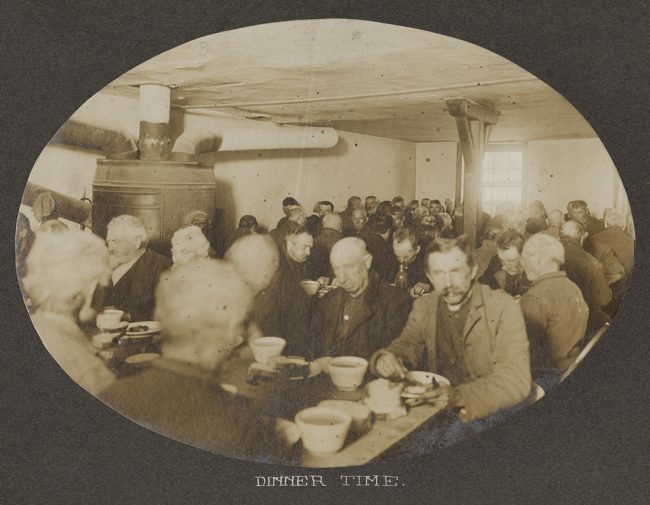
New York City Farm Colony “inmates” at meal time, 1904 | Photo courtesy of Vengoechea + Boyland Architecture/Urban Planning via NYC Municipal Archives
The site of the Landmark Colony makes up one half of the New York City Farm Colony–Seaview Hospital Historic District, designated in 1985 for its history as a canvas for experimentation in institutional design and idealistic notions of care for the city’s dependents. The other half, the 200-acre Seaview Hospital complex east of Brielle Avenue, has a social historical past equal to the Farm Colony’s. Dedicated in 1913, Seaview Hospital and Sanatorium administered the only known cure for the “white plague,” as tuberculosis was then known: rest, sunshine, and a bucolic setting. As the Landmark Preservation Commission’s report notes, “… it would appear that the Staten Island site, with its abundant space, beautiful landscape and absence of a determining architectural mode was a place particularly hospitable to the realization of [a] dream.”
That dream, in the 1820s and ‘30s, envisioned a wholesale cure for societal ills, a product of Jacksonian America’s increasing perception of poverty as a major social problem — and moral failing — in need of comprehensive repair. Until then, care for the aging and indigent remained a concern dealt with in the family or local community. The few almshouses that did exist provided for only the most extreme and desperate cases in small domestic architecture meant to substitute the family home. However, the new Jacksonian belief in solutions of scale led to a zealous faith in institutions, including a belief in the role of architecture in reforming the supposed moral deficits of the indigent.
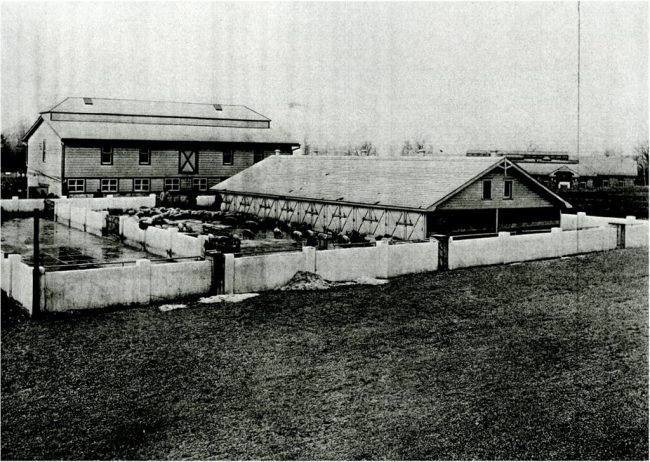
Farm Colony piggery and vegetable house, 1914 | Photo courtesy of Vengoechea + Boyland Architecture/Urban Planning via NYC Municipal Archives
In Staten Island, the County kept pace with the era’s grand institutional aspirations. In 1829, it acquired a 91-acre farm and reopened it a year later as the Richmond County Poor Farm. Its creators believed that laboring on a pastoral farm on the still rural island would provide the corrective moral measures needed by its “able-bodied paupers.”[4] After Staten Island’s incorporation into New York City in 1898, the newly renamed New York City Farm Colony and the newly built municipal Seaview tuberculosis hospital complex nearby became sites of innovative institutional design.
Rather than erecting vertical behemoths like the City’s facilities on Blackwell’s (now Roosevelt) Island, the Farm Colony’s architects took inspiration from their surroundings and a renewed perspective on “humane” housing. The resultant dormitories, dining halls, and complementary facilities more readily recalled the domestic designs of the eighteenth century colonial almshouse.

Produce cultivated at the Farm Colony, 1902 | Image courtesy of Nancy Owens Studio via NYC Municipal Archives
Well into the twentieth century, the farm required the residents to cultivate land to provide for themselves and the rest of the City’s dependent population. In 1912, the value of the farm’s produce exceeded $22,000, nearly $530,000 in 2015 dollars. Nevertheless, a census of the farm population from that same year betrays its emerging role: 52 percent of the residents were between the ages of 50 and 70, and 24 percent over 70. In the 1920s, administrators stopped requiring farm labor for room and board and instead emphasized it as a beneficial activity for more able-bodied residents, signaling a final shift away from the original character of the colony and, more generally, away from public charity as a corrective cure.
After several searing years of the Great Depression, the population reached an unprecedented 1,428 in 1936. The City’s few existing provisions for the poor, like the farm, served as merciful safety nets for those who succeeded in accessing them. However, the Depression also gave rise to provisions for care and old age that would ultimately render the farm obsolete: pensions and social security.
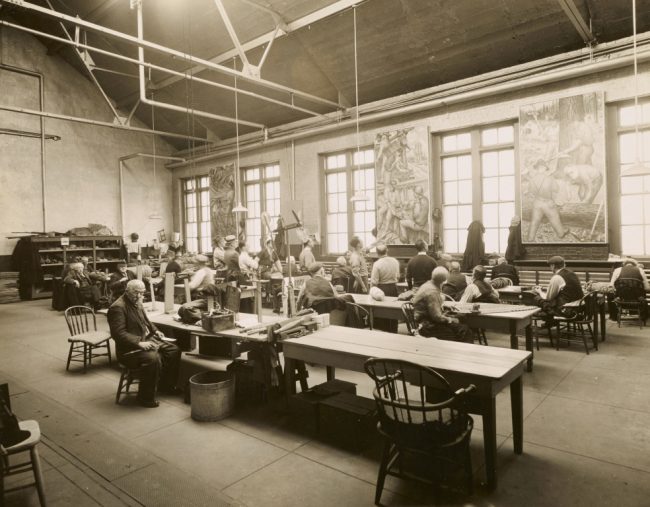
WPA murals inside the Farm Colony’s Laundry Building | Photo courtesy of Vengoechea + Boyland Architecture/Urban Planning via NYC Municipal Archives
While the farm maintained an institutional scale and sensibility, its overseers also made sincere efforts to enrich their boarders’ lives with art and entertainment, including vibrant WPA murals, frequent concerts, and other social engagements. One notable evening in 1953, Betty Impellitteri, wife of then Mayor Vincent Impellitteri, presided over the inauguration of the Farm’s “mayor.” A retired attorney, James McManus ran on the “Four Freedom” ticket: “free beer, free lunch, free enterprise, and free-for-all.”
By 1975, the process set in motion by the passage of the Social Security Act in 1935 concluded with the few remaining residents moving across the street to a City nursing home in Seaview. Since then, the red-brick dormitories, dining hall, laundry, and other industrial buildings have lain abandoned, crumbling into the fields of an old, unused farm.
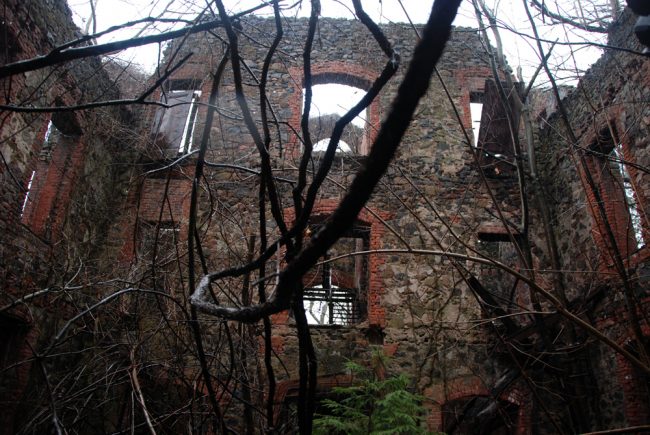
Interior of a men’s dormitory at the Farm Colony, 2014 | Photo by Nathan Kensinger
This storied past serves as an ever-present guide for the team developing the Landmark Colony, the partnership between NFC Associates and Vengoechea + Boyland Architecture/Urban Planning. On a recent tour of the Farm Colony, the history and the scale of the site were nearly overwhelming. So were the years of neglect that make the possibility of preserving what is left largely dependent on the project’s approval and development at the cost of close to $100 million.
That figure includes the high price of preservation, developed in accordance with the vision and requirements of the Landmark Preservation Commission. The plan entails the demolition of five buildings beyond repair with the salvaged materials to be repurposed elsewhere on the site; the rehabilitation and adaptive reuse of five other structures; and the stabilization of one structure as an arrested ruin, retaining some of the site’s eerie beauty of overgrown decay. The designs for the new residential construction — close to 20 two-story homes inspired by old cottages and carriage houses in the Dutch Colonial Revival style — reflect both the extant architecture and the smaller structures across Brielle Avenue at Seaview. Ninety percent of units will be market rate, with ten percent affordable to two-person households making up to 130 percent of the area median income, $89,830.[5] The plan also includes several publicly accessible elements, including a clubhouse and a small commercial building set along the avenue.
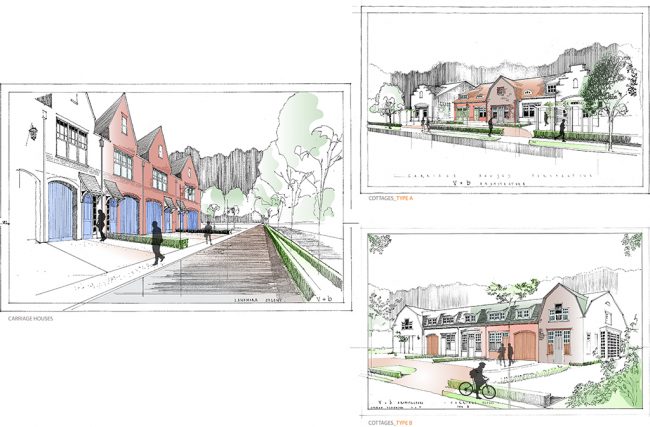
Rendered perspective views of Landmark Colony carriage houses and cottages | Image by Vengoechea + Boyland Architecture/Urban Planning
Tasked with the modern recreation of a lost landscape, Nancy Owens Studio has conceived a landscape design that references elements from the site’s cultivated pastoral past while meeting the programmatic and regulatory requirements of the present, such as optimal paths and routes of circulation for an aging population.
Owens also has the mandate of managing the Colony’s physical integration with the wider community. As Owens Studio’s Sylvia Barnett emphasized, “We thought a lot about how the site will interface with the surrounding neighborhood, as we did not want it to present as a private, walled-off community.” A significant portion of the site (according to Owens, 40%) will be publicly accessible open space. At the southern perimeter, where the site abuts New York City parkland, including the Staten Island Greenbelt, a knoll, pond, and amphitheater are planned. Along with the creation of newly developed open space, Barnett notes that, “the area was designed with the motive of sharing some of the history of the site with the public,” in part by incorporating the ruin.
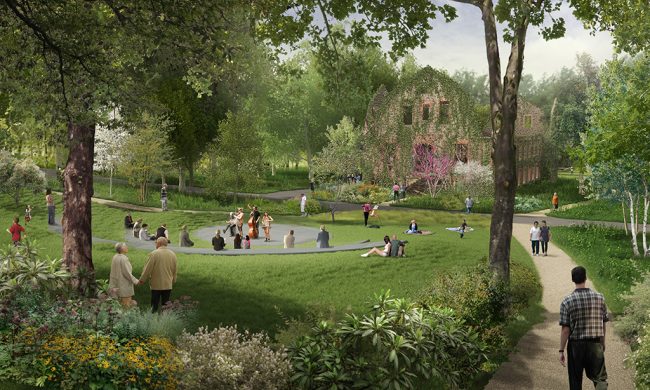
Rendering of amphitheater and arrested ruin along southern edge of the Landmark Colony | Image by Nancy Owens Studio
The plans, popularly regarded as the last hope of salvation for this important site in Staten Island and New York City history, have won blessings and accolades from Staten Island preservationists, environmentalists, and the community. Prior to the Landmark Colony, several potential projects for the site failed to materialize, including one with the Globe Institute of Technology in 2007 after a reduction in its federal funding. On selecting the Landmark Colony after a call for expressions of interest in 2012, Economic Development Corporation president, Kyle Kimball stated that, “The Landmark Colony project will rehabilitate a dilapidated area and create a facility that benefits the community while maintaining the integrity of this historic site.”
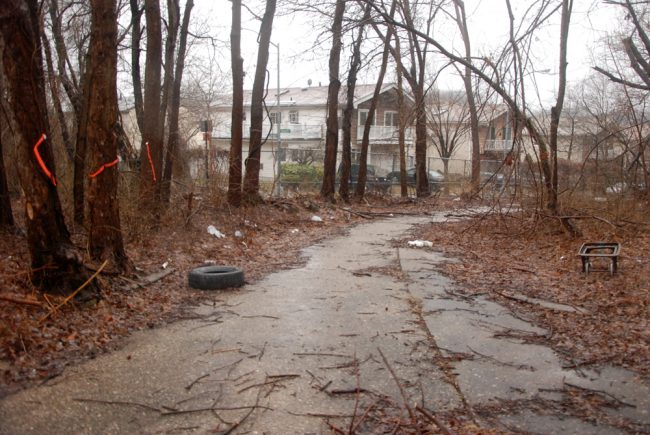
Residential neighborhoods abut the Farm Colony site. | Photo by Nathan Kensinger
A viable chance for revitalizing the site depended largely on a highly marketable development model with the financing required to cover the high costs of proper preservation, demolition, landscaping, building, and maintenance. Retirement communities for those 55 and over typically provide this level of funding. As Phil Stafford, the Director of the Center on Aging and Community at the University of Indiana at Bloomington, explained, “Much of senior housing is popular these days because it’s something you can get financing for.” Luxury, so-called “active-adult” or “young-old” communities like Landmark, while providing for only five to eight percent of the nation’s aging population, have become a highly desired real estate investment, leading to their proliferation beyond the familiar territories of suburban Arizona or Florida.
Raymond Masucci of NFC Associates brought New York its first 55+ community in 2009 with The Tides, just north of the Outerbridge Crossing in the Charleston neighborhood of Staten Island. A gated community on the water, the Tides has proven popular with its residents, and houses currently on the market range from the mid $500,000s to low $600,000s. Along with their marketability, the popularity of 55+ communities with developers and community boards also stems from the passage of the 1995 federal Housing for Older Persons Act, which made it easy for developments to exclude children, thereby expanding the taxbase without necessarily having to increase services. “It is a huge industry,” noted Scott Ball, an architect and author of Livable Communities for Aging Populations. “Last year TIAA-CREF tracked it for the first time as an asset class, and it outperformed … every other real estate asset class by about 40 percent. Blackstone is in it now; Citigroup is in it. … In some places it is the only housing being built.”
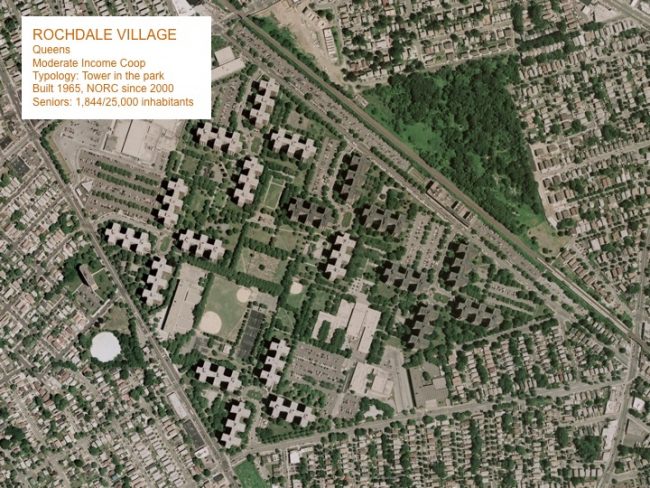
Rochdale Village, Queens: a New York City NORC | Image courtesy of Interboro Partners
The segregation of seniors within retirement communities raises other serious questions about this growing trend. Today, most experts emphasize the benefits of aging in place, such as continuity within their community and connection to place. Other qualities of an ideal environment for growing old include access to care, convenient and comprehensive public transportation, and nearby retail outlets. Landmark Colony does not possess many of these criteria, engendering some skepticism about the kind of housing and planning the City should focus on and incentivize to provide its seniors with a sustainable, fulfilling, and dignified future.
Whether by design or by chance, New York City has a tradition of accommodating and encouraging aging in place. Twenty-seven NORCs, or Naturally Occurring Retirement Communities, now exist in midcentury high-rises across four boroughs, excluding Staten Island. These developments possess a sizeable aging population and qualify for local, state, and federal funds to provide the services their residents have grown to require. The City’s rent subsidy and home health attendant assistance programs also enable elderly New Yorkers to remain in their homes, out of desire or necessity. And with poverty among New York’s elderly exceeding national figures and increasing, Mayor de Blasio’s housing plan seeks to stimulate the development of affordable housing specifically built for seniors, rather than overwhelmingly market rate construction like the Landmark Colony.
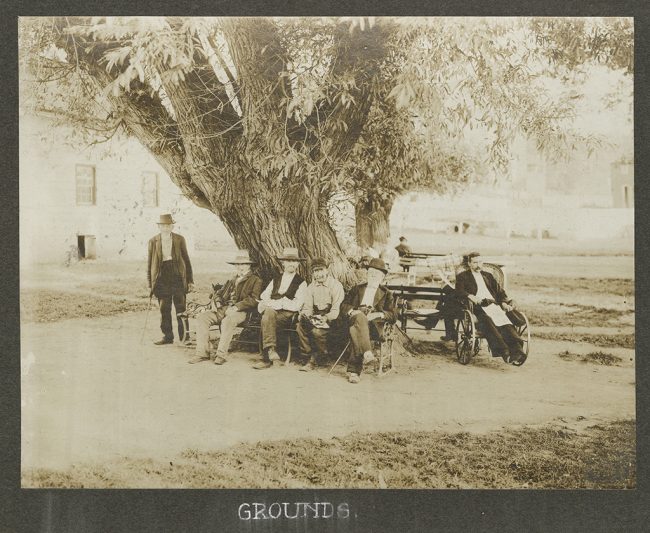
Men at the New York City Farm Colony, 1904 | Photo courtesy of Vengoechea + Boyland Architecture/Urban Planning via NYC Municipal Archives
However, many arguments also exist for later-life housing models like Landmark Colony and other aging-in-place alternatives. As Deane Simpson writes in Young-Old: Urban Utopias of An Aging Society, “While aging in place has been presented as both the default and the ideal housing option for the Young-Old, there are a range of challenges associated with it. One challenge addresses the potential to over-romanticize the concept of place-attachment.” Furthermore, as Scott Ball writes, “Senior housing has evolved separate from its larger urban context, in part out of necessity. As aging-in-place advocates are fully aware, the nation’s built environment is in many ways not capable of supporting an individual’s needs across a lifespan.” The makeup of communities also change over time, and as their demographics shift, the same neighborhood may not serve as an ideal place for an individual for whom they once fostered a comfortable and convenient home.
Over the last century, Americans have grown increasingly mobile, with the average person moving 11.7 times in a lifetime. Home then, might be a less physically fixed concept than it once was, often changing with each phase of life. While an AARP survey shows that nearly 90 percent of retirees prefer aging in place, a 2005 Del Webb Baby Boomer survey indicates that individuals nearing retirement are highly mobile, and far more likely to select a home that addresses their immediate needs. Moreover, 45 percent of those willing to buy a new home for retirement also showed a readiness to do so out of state.[6] Whether the mobility is born out of necessity or choice is unclear.
While the Landmark Colony will serve a population that seems to least need more choice, it also provides the type of retirement community that those aging in Staten Island may have left the city for. Many of the qualities of New York that serve seniors well, such as easily accessible public transportation and the convenience of retail near residences, do not typify Staten Island. This type of retirement development is, for better or worse, an extension of the borough’s existing character, and of the local context as well. Across Brielle Avenue at Seaview, several models for care and housing for the aging already exist, including a private assisted living facility, a city-run nursing home, and Park Lane, another retirement community.
One remedy for the perceived shortcomings of segregating and uprooting seniors into retirement communities and nursing homes may lie in the interdependence of the services and amenities that this concentration of institutions can allow. Only a few months prior to the announcement of the Landmark project, then City Council Member and current Staten Island Borough President James Oddo announced a plan for a “Staten Island Health and Wellness Campus” at Seaview that would include a residential community for children and adults with special needs, a 55+ community with special provisions for those with Alzheimer’s, and a cancer treatment and research institute served by an organic farm, greenhouse, and farmers’ market. However, as the Landmark Colony nears groundbreaking, the rest of Oddo’s plans have yet to materialize. Not unlike the notable architecture of the Farm Colony, the last remaining patient pavilion from the original Seaview hospital lies severely abandoned and crumbling, destined for demolition unless a match is made between the City and an appropriate developer. It is arguably the site’s most beautiful building, almost completely encased in windows and topped with a gilded mosaic depicting doctors and orderlies.
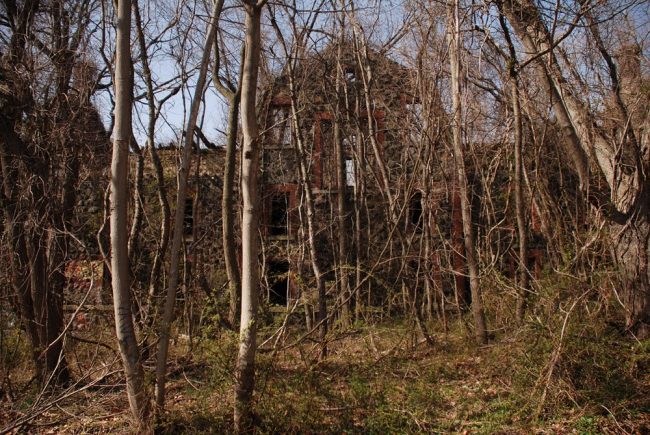
Obscured ruins, 2011 | Photo by Nathan Kensinger
Innovations in care and housing for seniors often supplant solutions once considered revolutionary. The New York City Poor Farm would have provided another option for Simion Corne and his wife, and Social Security ultimately preempted the total desperation that brought the destitute and aging to the farm’s doors. However, the built environment has had difficulty keeping up with the radical evolution of aging in the last century. Nursing homes, once the vanguard of elder care, now stand almost universally reviled, and even assisted living facilities seem to many like a recent remedy already growing obsolete. As experts focus on aging in place as a more holistic solution, boomers, and developers catering to them, are creating another reality of contemporary aging.
The Landmark Colony may raise many questions about ideal planning for seniors, but it also provides a new choice for Staten Islanders, and all New Yorkers, in an area of the city where aging in place seems least viable. Its value as a preservation project remains undeniable, a whole chapter of New York history lost without it. Along with providing for a rapidly aging borough, it may soon anchor new life in a part of Staten Island that has been an empty shell for decades, fostering new connections to a place that nearly ceased to exist.
[1] Charles W. Leng and William T. Davis, Staten Island and Its People: A History, 1609-1929. New York: Lewis Historical Publishing Company, 1930, p.577.
[2] According to projections by the New York City Department for the Aging, by 2030 the city’s population over 60 will increase 47 percent to 1.84 million and comprise 20 percent of the city’s population, up from 15 percent in 2000.
[3] At the time of publication, an EDC spokesperson would not confirm the amount of the nominal fee.
[4] Landmarks Preservation Commission, New York City Farm Colony-Seaview Hospital Historic District Designation Report, 1985, p.7.
[5] NFC Associates would not confirm its planned pricing for units at the Landmark Colony.
[6] Deane Simpson, Young-Old: Urban Utopias of an Aging Society. Lars Muller Publishers, 2015, pp.46-47.
The views expressed here are those of the authors only and do not reflect the position of The Architectural League of New York.
Comments